EHR Project Implementation: Team Roles, Responsibilities, and Impact
VerifiedAdded on 2023/04/08
|8
|1681
|309
Report
AI Summary
This report provides a detailed overview of Electronic Health Record (EHR) project implementation within healthcare organizations. It emphasizes the importance of a well-structured EHR implementation team, outlining the roles and responsibilities of fourteen key members, including the EHR Team Leader, Implementation Manager, Physician Champion, Nurse Leader, Medical Assistant Lead, and IT Lead. The report discusses how each role contributes to the successful adoption and utilization of the EHR system, from initial planning and coordination to workflow redesign and user training. Furthermore, it highlights the significance of stakeholder engagement and collaboration in ensuring that the EHR implementation aligns with the organization's needs and improves patient care. The document concludes with a list of references used in compiling the report.

Running Head: EHR PROJECT IMPLEMENTATION
1
EHR Project Implementation
Name
Institution Affiliate
1
EHR Project Implementation
Name
Institution Affiliate
Paraphrase This Document
Need a fresh take? Get an instant paraphrase of this document with our AI Paraphraser
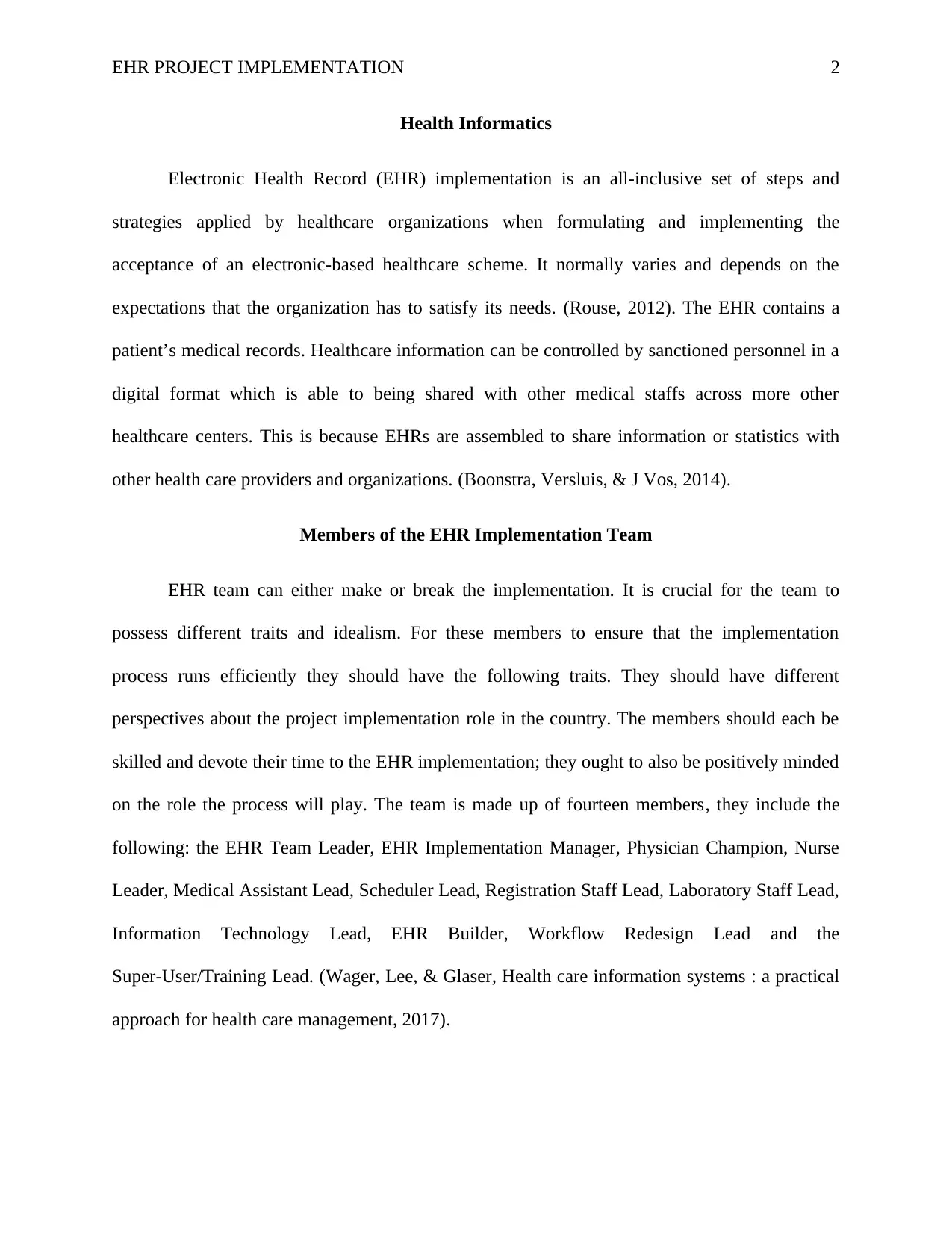
EHR PROJECT IMPLEMENTATION 2
Health Informatics
Electronic Health Record (EHR) implementation is an all-inclusive set of steps and
strategies applied by healthcare organizations when formulating and implementing the
acceptance of an electronic-based healthcare scheme. It normally varies and depends on the
expectations that the organization has to satisfy its needs. (Rouse, 2012). The EHR contains a
patient’s medical records. Healthcare information can be controlled by sanctioned personnel in a
digital format which is able to being shared with other medical staffs across more other
healthcare centers. This is because EHRs are assembled to share information or statistics with
other health care providers and organizations. (Boonstra, Versluis, & J Vos, 2014).
Members of the EHR Implementation Team
EHR team can either make or break the implementation. It is crucial for the team to
possess different traits and idealism. For these members to ensure that the implementation
process runs efficiently they should have the following traits. They should have different
perspectives about the project implementation role in the country. The members should each be
skilled and devote their time to the EHR implementation; they ought to also be positively minded
on the role the process will play. The team is made up of fourteen members, they include the
following: the EHR Team Leader, EHR Implementation Manager, Physician Champion, Nurse
Leader, Medical Assistant Lead, Scheduler Lead, Registration Staff Lead, Laboratory Staff Lead,
Information Technology Lead, EHR Builder, Workflow Redesign Lead and the
Super-User/Training Lead. (Wager, Lee, & Glaser, Health care information systems : a practical
approach for health care management, 2017).
Health Informatics
Electronic Health Record (EHR) implementation is an all-inclusive set of steps and
strategies applied by healthcare organizations when formulating and implementing the
acceptance of an electronic-based healthcare scheme. It normally varies and depends on the
expectations that the organization has to satisfy its needs. (Rouse, 2012). The EHR contains a
patient’s medical records. Healthcare information can be controlled by sanctioned personnel in a
digital format which is able to being shared with other medical staffs across more other
healthcare centers. This is because EHRs are assembled to share information or statistics with
other health care providers and organizations. (Boonstra, Versluis, & J Vos, 2014).
Members of the EHR Implementation Team
EHR team can either make or break the implementation. It is crucial for the team to
possess different traits and idealism. For these members to ensure that the implementation
process runs efficiently they should have the following traits. They should have different
perspectives about the project implementation role in the country. The members should each be
skilled and devote their time to the EHR implementation; they ought to also be positively minded
on the role the process will play. The team is made up of fourteen members, they include the
following: the EHR Team Leader, EHR Implementation Manager, Physician Champion, Nurse
Leader, Medical Assistant Lead, Scheduler Lead, Registration Staff Lead, Laboratory Staff Lead,
Information Technology Lead, EHR Builder, Workflow Redesign Lead and the
Super-User/Training Lead. (Wager, Lee, & Glaser, Health care information systems : a practical
approach for health care management, 2017).
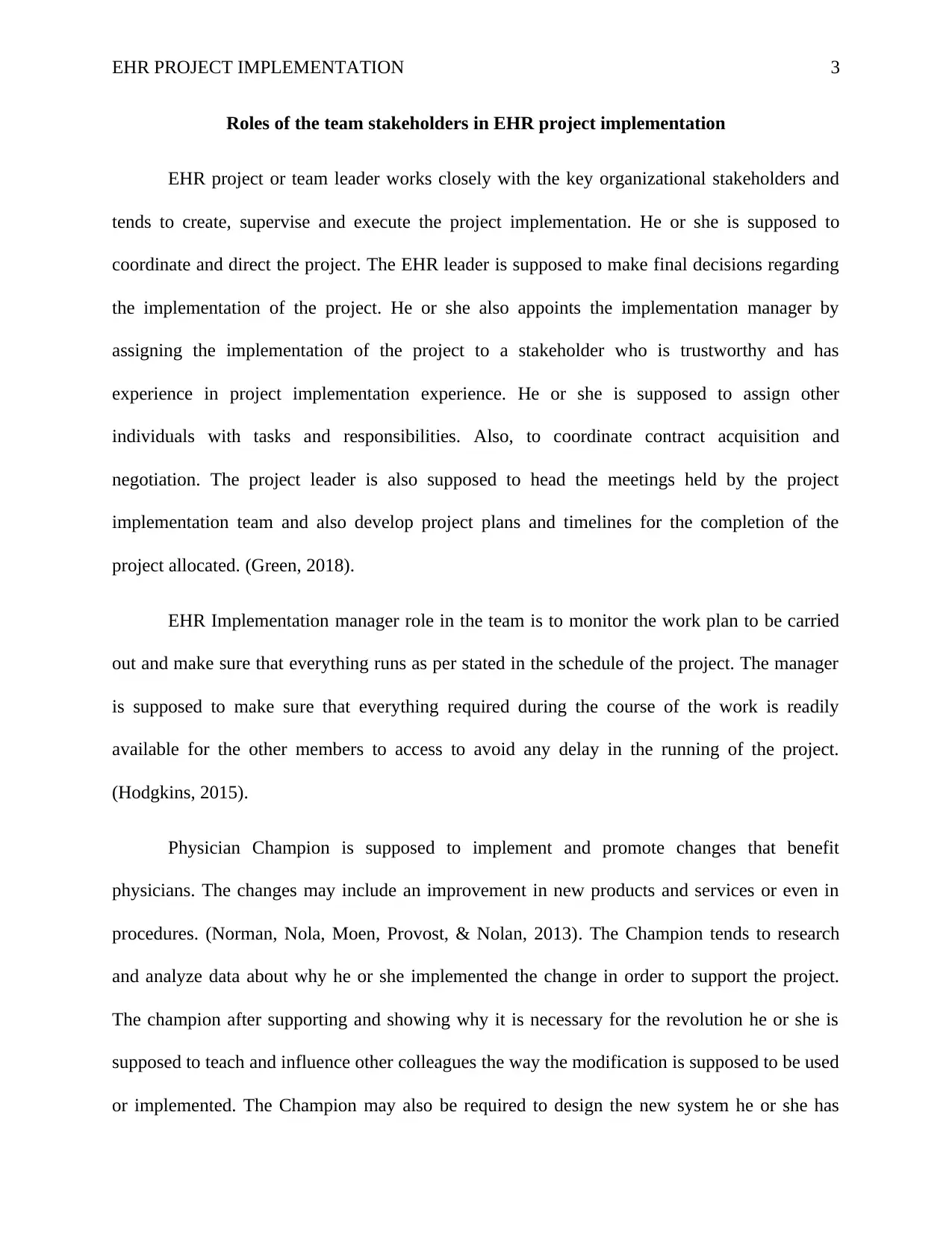
EHR PROJECT IMPLEMENTATION 3
Roles of the team stakeholders in EHR project implementation
EHR project or team leader works closely with the key organizational stakeholders and
tends to create, supervise and execute the project implementation. He or she is supposed to
coordinate and direct the project. The EHR leader is supposed to make final decisions regarding
the implementation of the project. He or she also appoints the implementation manager by
assigning the implementation of the project to a stakeholder who is trustworthy and has
experience in project implementation experience. He or she is supposed to assign other
individuals with tasks and responsibilities. Also, to coordinate contract acquisition and
negotiation. The project leader is also supposed to head the meetings held by the project
implementation team and also develop project plans and timelines for the completion of the
project allocated. (Green, 2018).
EHR Implementation manager role in the team is to monitor the work plan to be carried
out and make sure that everything runs as per stated in the schedule of the project. The manager
is supposed to make sure that everything required during the course of the work is readily
available for the other members to access to avoid any delay in the running of the project.
(Hodgkins, 2015).
Physician Champion is supposed to implement and promote changes that benefit
physicians. The changes may include an improvement in new products and services or even in
procedures. (Norman, Nola, Moen, Provost, & Nolan, 2013). The Champion tends to research
and analyze data about why he or she implemented the change in order to support the project.
The champion after supporting and showing why it is necessary for the revolution he or she is
supposed to teach and influence other colleagues the way the modification is supposed to be used
or implemented. The Champion may also be required to design the new system he or she has
Roles of the team stakeholders in EHR project implementation
EHR project or team leader works closely with the key organizational stakeholders and
tends to create, supervise and execute the project implementation. He or she is supposed to
coordinate and direct the project. The EHR leader is supposed to make final decisions regarding
the implementation of the project. He or she also appoints the implementation manager by
assigning the implementation of the project to a stakeholder who is trustworthy and has
experience in project implementation experience. He or she is supposed to assign other
individuals with tasks and responsibilities. Also, to coordinate contract acquisition and
negotiation. The project leader is also supposed to head the meetings held by the project
implementation team and also develop project plans and timelines for the completion of the
project allocated. (Green, 2018).
EHR Implementation manager role in the team is to monitor the work plan to be carried
out and make sure that everything runs as per stated in the schedule of the project. The manager
is supposed to make sure that everything required during the course of the work is readily
available for the other members to access to avoid any delay in the running of the project.
(Hodgkins, 2015).
Physician Champion is supposed to implement and promote changes that benefit
physicians. The changes may include an improvement in new products and services or even in
procedures. (Norman, Nola, Moen, Provost, & Nolan, 2013). The Champion tends to research
and analyze data about why he or she implemented the change in order to support the project.
The champion after supporting and showing why it is necessary for the revolution he or she is
supposed to teach and influence other colleagues the way the modification is supposed to be used
or implemented. The Champion may also be required to design the new system he or she has
⊘ This is a preview!⊘
Do you want full access?
Subscribe today to unlock all pages.

Trusted by 1+ million students worldwide
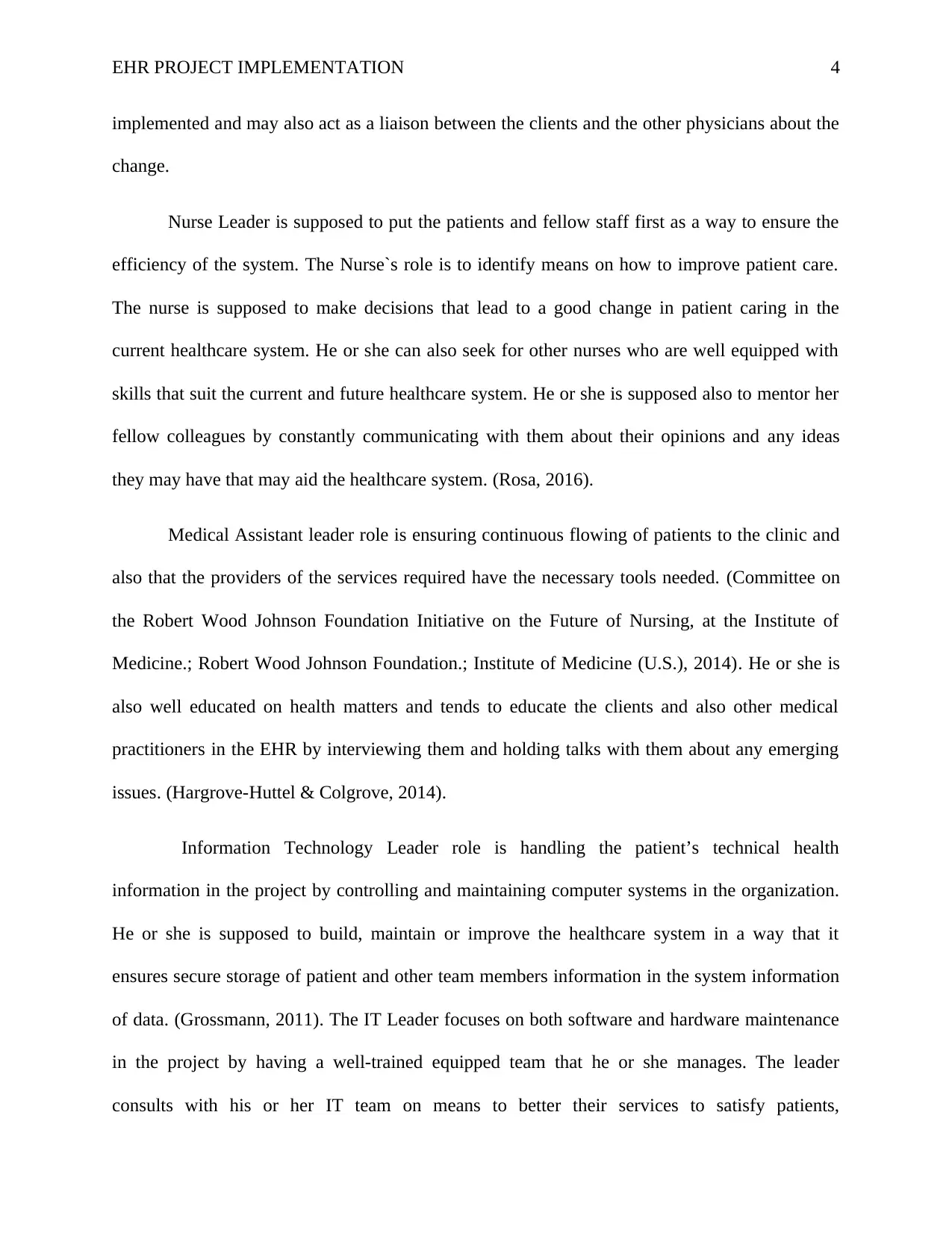
EHR PROJECT IMPLEMENTATION 4
implemented and may also act as a liaison between the clients and the other physicians about the
change.
Nurse Leader is supposed to put the patients and fellow staff first as a way to ensure the
efficiency of the system. The Nurse`s role is to identify means on how to improve patient care.
The nurse is supposed to make decisions that lead to a good change in patient caring in the
current healthcare system. He or she can also seek for other nurses who are well equipped with
skills that suit the current and future healthcare system. He or she is supposed also to mentor her
fellow colleagues by constantly communicating with them about their opinions and any ideas
they may have that may aid the healthcare system. (Rosa, 2016).
Medical Assistant leader role is ensuring continuous flowing of patients to the clinic and
also that the providers of the services required have the necessary tools needed. (Committee on
the Robert Wood Johnson Foundation Initiative on the Future of Nursing, at the Institute of
Medicine.; Robert Wood Johnson Foundation.; Institute of Medicine (U.S.), 2014). He or she is
also well educated on health matters and tends to educate the clients and also other medical
practitioners in the EHR by interviewing them and holding talks with them about any emerging
issues. (Hargrove-Huttel & Colgrove, 2014).
Information Technology Leader role is handling the patient’s technical health
information in the project by controlling and maintaining computer systems in the organization.
He or she is supposed to build, maintain or improve the healthcare system in a way that it
ensures secure storage of patient and other team members information in the system information
of data. (Grossmann, 2011). The IT Leader focuses on both software and hardware maintenance
in the project by having a well-trained equipped team that he or she manages. The leader
consults with his or her IT team on means to better their services to satisfy patients,
implemented and may also act as a liaison between the clients and the other physicians about the
change.
Nurse Leader is supposed to put the patients and fellow staff first as a way to ensure the
efficiency of the system. The Nurse`s role is to identify means on how to improve patient care.
The nurse is supposed to make decisions that lead to a good change in patient caring in the
current healthcare system. He or she can also seek for other nurses who are well equipped with
skills that suit the current and future healthcare system. He or she is supposed also to mentor her
fellow colleagues by constantly communicating with them about their opinions and any ideas
they may have that may aid the healthcare system. (Rosa, 2016).
Medical Assistant leader role is ensuring continuous flowing of patients to the clinic and
also that the providers of the services required have the necessary tools needed. (Committee on
the Robert Wood Johnson Foundation Initiative on the Future of Nursing, at the Institute of
Medicine.; Robert Wood Johnson Foundation.; Institute of Medicine (U.S.), 2014). He or she is
also well educated on health matters and tends to educate the clients and also other medical
practitioners in the EHR by interviewing them and holding talks with them about any emerging
issues. (Hargrove-Huttel & Colgrove, 2014).
Information Technology Leader role is handling the patient’s technical health
information in the project by controlling and maintaining computer systems in the organization.
He or she is supposed to build, maintain or improve the healthcare system in a way that it
ensures secure storage of patient and other team members information in the system information
of data. (Grossmann, 2011). The IT Leader focuses on both software and hardware maintenance
in the project by having a well-trained equipped team that he or she manages. The leader
consults with his or her IT team on means to better their services to satisfy patients,
Paraphrase This Document
Need a fresh take? Get an instant paraphrase of this document with our AI Paraphraser

EHR PROJECT IMPLEMENTATION 5
communication services, data storage services, and also design programs that make it easier to
access patients records for future and current references.
Schedule Leader is supposed to be conversant with scheduling workflows in the system
in order to motivate scheduling staff to accept change and help them to understand it. The leader
and his team of staff tend to play a central role in the running of the project. He or she is
supposed to always consult with the team in order to drive an agreement between the scheduling
staff for them to grasp the importance of the change and how it influences the project. (Anderson
& Holcombe, 2013)
Registration staff leader role is similar to that of the schedule lead because the leader
tends to motivate other registration staff to accept change and encourage agreements between
registration staff. This is also similar to the Lab Staff Lead, only that the lab staff Leader
motivates the Lab staff. He or she does also play a central role in the project’s implementation.
EHR Builder is responsible for constructing and customizing any areas that need
rectification in the project. The leader is also supposed to educate his or her staff team on the
various tasks they should do to improve or facilitate the steady running of the project. EHR
Builder tends to be aware of many functions to be carried out in the project than other
stakeholders since he deals with the vendors supplying the facilities himself. He or she also can
train new staff recruits on what is expected of them to do during the running of the project
(Wager, Lee, & Glaser, , 2017).
Workflow Redesign Leader role is to train staff either new or old staff on how to evaluate
existing workflows and redesign them during the implementation of the project. The Lead can
also incorporate and train workflow redesign that integrates with the attainment of quality
communication services, data storage services, and also design programs that make it easier to
access patients records for future and current references.
Schedule Leader is supposed to be conversant with scheduling workflows in the system
in order to motivate scheduling staff to accept change and help them to understand it. The leader
and his team of staff tend to play a central role in the running of the project. He or she is
supposed to always consult with the team in order to drive an agreement between the scheduling
staff for them to grasp the importance of the change and how it influences the project. (Anderson
& Holcombe, 2013)
Registration staff leader role is similar to that of the schedule lead because the leader
tends to motivate other registration staff to accept change and encourage agreements between
registration staff. This is also similar to the Lab Staff Lead, only that the lab staff Leader
motivates the Lab staff. He or she does also play a central role in the project’s implementation.
EHR Builder is responsible for constructing and customizing any areas that need
rectification in the project. The leader is also supposed to educate his or her staff team on the
various tasks they should do to improve or facilitate the steady running of the project. EHR
Builder tends to be aware of many functions to be carried out in the project than other
stakeholders since he deals with the vendors supplying the facilities himself. He or she also can
train new staff recruits on what is expected of them to do during the running of the project
(Wager, Lee, & Glaser, , 2017).
Workflow Redesign Leader role is to train staff either new or old staff on how to evaluate
existing workflows and redesign them during the implementation of the project. The Lead can
also incorporate and train workflow redesign that integrates with the attainment of quality
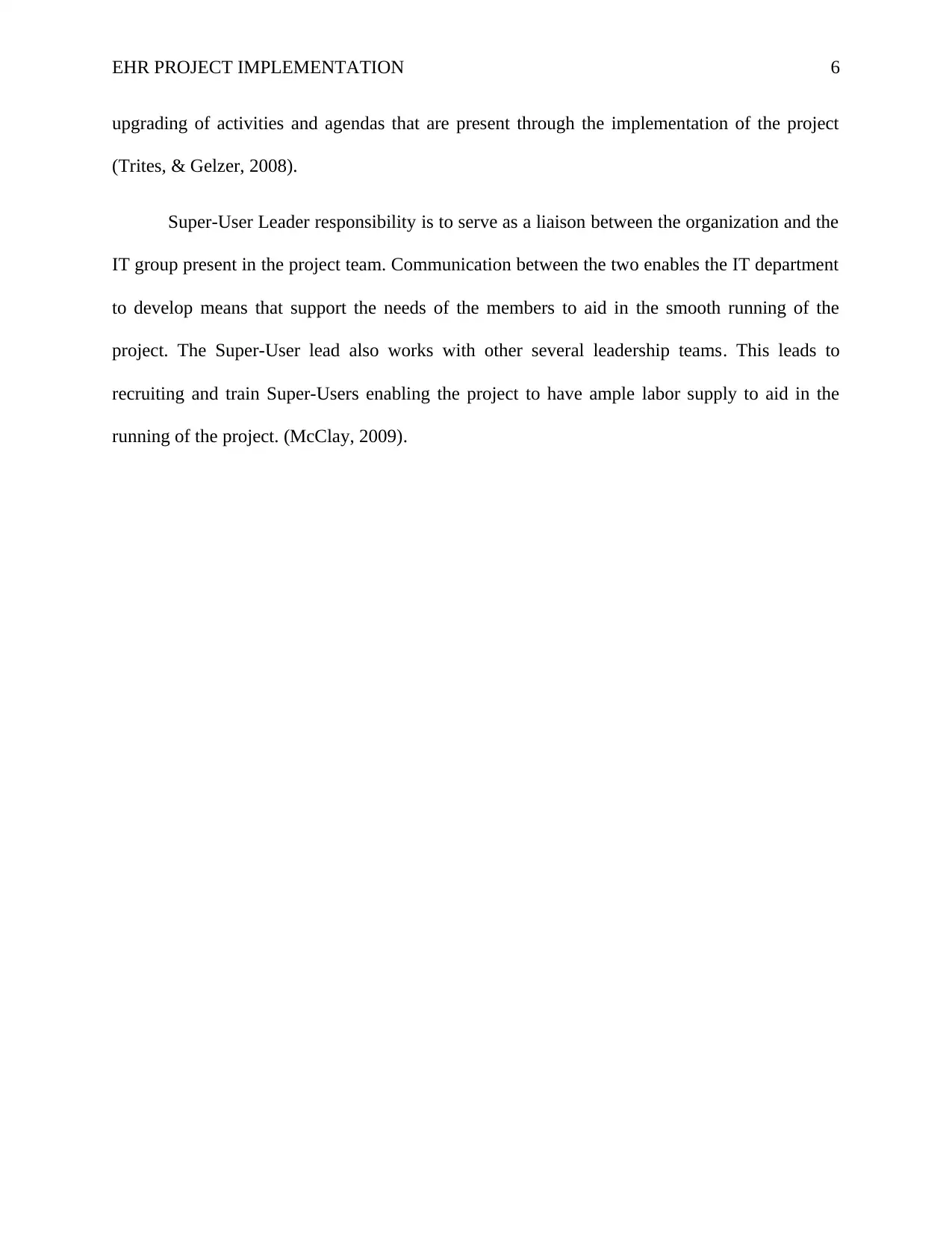
EHR PROJECT IMPLEMENTATION 6
upgrading of activities and agendas that are present through the implementation of the project
(Trites, & Gelzer, 2008).
Super-User Leader responsibility is to serve as a liaison between the organization and the
IT group present in the project team. Communication between the two enables the IT department
to develop means that support the needs of the members to aid in the smooth running of the
project. The Super-User lead also works with other several leadership teams. This leads to
recruiting and train Super-Users enabling the project to have ample labor supply to aid in the
running of the project. (McClay, 2009).
upgrading of activities and agendas that are present through the implementation of the project
(Trites, & Gelzer, 2008).
Super-User Leader responsibility is to serve as a liaison between the organization and the
IT group present in the project team. Communication between the two enables the IT department
to develop means that support the needs of the members to aid in the smooth running of the
project. The Super-User lead also works with other several leadership teams. This leads to
recruiting and train Super-Users enabling the project to have ample labor supply to aid in the
running of the project. (McClay, 2009).
⊘ This is a preview!⊘
Do you want full access?
Subscribe today to unlock all pages.

Trusted by 1+ million students worldwide
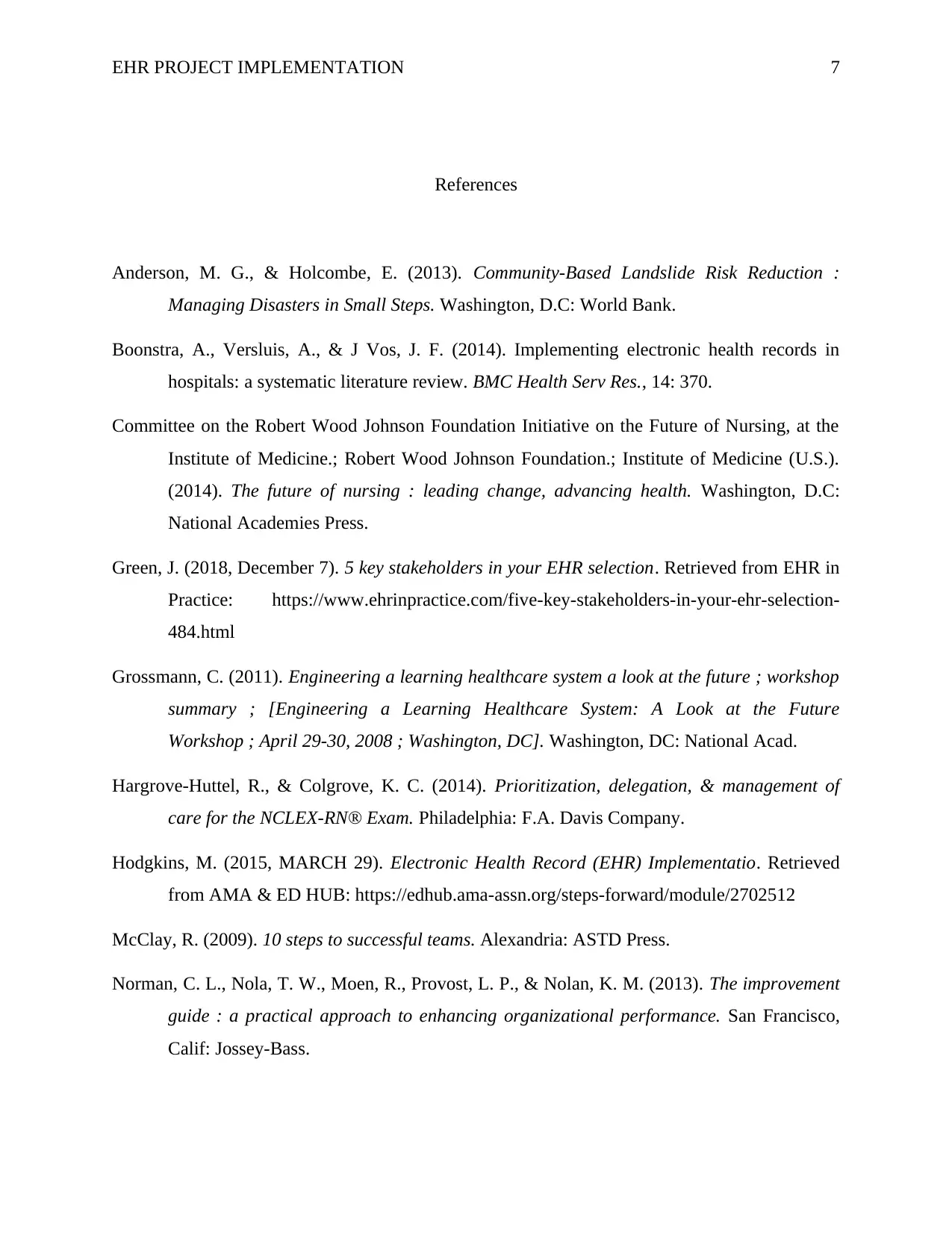
EHR PROJECT IMPLEMENTATION 7
References
Anderson, M. G., & Holcombe, E. (2013). Community-Based Landslide Risk Reduction :
Managing Disasters in Small Steps. Washington, D.C: World Bank.
Boonstra, A., Versluis, A., & J Vos, J. F. (2014). Implementing electronic health records in
hospitals: a systematic literature review. BMC Health Serv Res., 14: 370.
Committee on the Robert Wood Johnson Foundation Initiative on the Future of Nursing, at the
Institute of Medicine.; Robert Wood Johnson Foundation.; Institute of Medicine (U.S.).
(2014). The future of nursing : leading change, advancing health. Washington, D.C:
National Academies Press.
Green, J. (2018, December 7). 5 key stakeholders in your EHR selection. Retrieved from EHR in
Practice: https://www.ehrinpractice.com/five-key-stakeholders-in-your-ehr-selection-
484.html
Grossmann, C. (2011). Engineering a learning healthcare system a look at the future ; workshop
summary ; [Engineering a Learning Healthcare System: A Look at the Future
Workshop ; April 29-30, 2008 ; Washington, DC]. Washington, DC: National Acad.
Hargrove-Huttel, R., & Colgrove, K. C. (2014). Prioritization, delegation, & management of
care for the NCLEX-RN® Exam. Philadelphia: F.A. Davis Company.
Hodgkins, M. (2015, MARCH 29). Electronic Health Record (EHR) Implementatio. Retrieved
from AMA & ED HUB: https://edhub.ama-assn.org/steps-forward/module/2702512
McClay, R. (2009). 10 steps to successful teams. Alexandria: ASTD Press.
Norman, C. L., Nola, T. W., Moen, R., Provost, L. P., & Nolan, K. M. (2013). The improvement
guide : a practical approach to enhancing organizational performance. San Francisco,
Calif: Jossey-Bass.
References
Anderson, M. G., & Holcombe, E. (2013). Community-Based Landslide Risk Reduction :
Managing Disasters in Small Steps. Washington, D.C: World Bank.
Boonstra, A., Versluis, A., & J Vos, J. F. (2014). Implementing electronic health records in
hospitals: a systematic literature review. BMC Health Serv Res., 14: 370.
Committee on the Robert Wood Johnson Foundation Initiative on the Future of Nursing, at the
Institute of Medicine.; Robert Wood Johnson Foundation.; Institute of Medicine (U.S.).
(2014). The future of nursing : leading change, advancing health. Washington, D.C:
National Academies Press.
Green, J. (2018, December 7). 5 key stakeholders in your EHR selection. Retrieved from EHR in
Practice: https://www.ehrinpractice.com/five-key-stakeholders-in-your-ehr-selection-
484.html
Grossmann, C. (2011). Engineering a learning healthcare system a look at the future ; workshop
summary ; [Engineering a Learning Healthcare System: A Look at the Future
Workshop ; April 29-30, 2008 ; Washington, DC]. Washington, DC: National Acad.
Hargrove-Huttel, R., & Colgrove, K. C. (2014). Prioritization, delegation, & management of
care for the NCLEX-RN® Exam. Philadelphia: F.A. Davis Company.
Hodgkins, M. (2015, MARCH 29). Electronic Health Record (EHR) Implementatio. Retrieved
from AMA & ED HUB: https://edhub.ama-assn.org/steps-forward/module/2702512
McClay, R. (2009). 10 steps to successful teams. Alexandria: ASTD Press.
Norman, C. L., Nola, T. W., Moen, R., Provost, L. P., & Nolan, K. M. (2013). The improvement
guide : a practical approach to enhancing organizational performance. San Francisco,
Calif: Jossey-Bass.
Paraphrase This Document
Need a fresh take? Get an instant paraphrase of this document with our AI Paraphraser

EHR PROJECT IMPLEMENTATION 8
Rosa, W. (2016). Nurses as leaders : evolutionary visions of leadership. New York: Springer
Publishing Company.
Rouse, M. (2012, February). EHR implementation plan. Retrieved from TECHTARGET
NETWORK: https://searchhealthit.techtarget.com/definition/EHR-implementation-plan
Trites, P. A., & Gelzer, R. D. (2008). How to evaluate electronic health record (EHR) systems.
Chicago: American Health Information Management Association.
Wager, K. A., Lee, F. W., & Glaser, J. P. (2017). Health care information systems : a practical
approach for health care management. San Francisco, CA : Jossey-Bass.
Wager, K. A., Lee, F. W., & Glaser, J. P. (2017). Health care information systems : a practical
approach for health care management. San Francisco: Jossey-Bass.
Rosa, W. (2016). Nurses as leaders : evolutionary visions of leadership. New York: Springer
Publishing Company.
Rouse, M. (2012, February). EHR implementation plan. Retrieved from TECHTARGET
NETWORK: https://searchhealthit.techtarget.com/definition/EHR-implementation-plan
Trites, P. A., & Gelzer, R. D. (2008). How to evaluate electronic health record (EHR) systems.
Chicago: American Health Information Management Association.
Wager, K. A., Lee, F. W., & Glaser, J. P. (2017). Health care information systems : a practical
approach for health care management. San Francisco, CA : Jossey-Bass.
Wager, K. A., Lee, F. W., & Glaser, J. P. (2017). Health care information systems : a practical
approach for health care management. San Francisco: Jossey-Bass.
1 out of 8
Related Documents
Your All-in-One AI-Powered Toolkit for Academic Success.
+13062052269
info@desklib.com
Available 24*7 on WhatsApp / Email
![[object Object]](/_next/static/media/star-bottom.7253800d.svg)
Unlock your academic potential
Copyright © 2020–2025 A2Z Services. All Rights Reserved. Developed and managed by ZUCOL.





